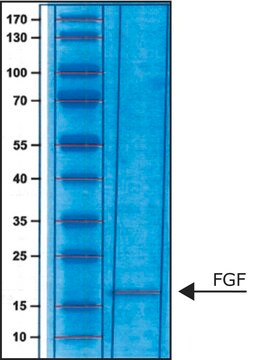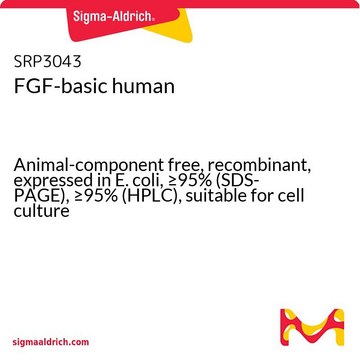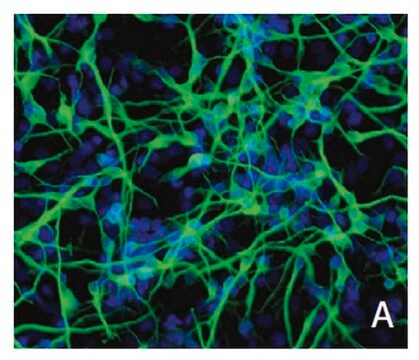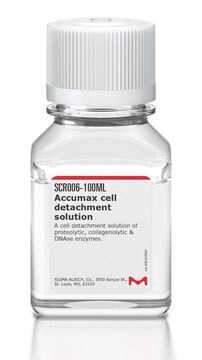GF003AF
Fibroblast Growth Factor basic, human
Animal free, >95% (SDS-PAGE), recombinant, expressed in E. coli, suitable for cell culture
Synonim(y):
FGF-2, bFGF, basic-FGF, Heparin-Binding Growth Factor 2, Prostatropin
About This Item
Polecane produkty
product name
Fibroblast Growth Factor basic, human recombinant, animal-free, The Fibroblast Growth Factor-basic (or bFGF protein) is a heparin binding growth factor which stimulates the proliferation of a wide variety of cells including mesenchymal, neuroectodermal & endothelial cells.
pochodzenie biologiczne
human
Poziom jakości
Próba
>95% (SDS-PAGE)
producent / nazwa handlowa
Chemicon®
metody
cell culture | stem cell: suitable
zanieczyszczenia
<0.1 EU/μg Endotoxin (of bFGF)
moc wejściowa
sample type epithelial cells
sample type mesenchymal stem cell(s)
sample type: human embryonic stem cell(s)
sample type neural stem cell(s)
sample type pancreatic stem cell(s)
numer dostępu NCBI
numer dostępu UniProt
Opis ogólny
Zastosowanie
Postać fizyczna
Przechowywanie i stabilność
General applications:
After a quick spin, reconstitute in 0.1M phosphate buffer, pH 6.8, to a concentration of 0.1-1.0 mg/mL. Reconstituted bFGF should be stored in working aliquots at -20°C for up to six months. Multiple freeze/thaw cycles will result in significant loss of activity.
For Human ES cell culture:
After a quick spin, reconstitute to 10 μg/mL in a filtered solution of 0.5% BSA, 1 mM DTT, and 10% glycerol in Dulbecco′s PBS. Aliquot and store at -20°C for up to six months. This solution can then thawed and diluted to 4 ng/mL for the culture of human ES cells with a feeder layer, or to 8 ng/mL to supplement mouse embryonic fibroblast-conditioned medium (for feeder-free human ES cell culture).
Komentarz do analizy
Informacje prawne
Oświadczenie o zrzeczeniu się odpowiedzialności
Kod klasy składowania
11 - Combustible Solids
Klasa zagrożenia wodnego (WGK)
WGK 3
Certyfikaty analizy (CoA)
Poszukaj Certyfikaty analizy (CoA), wpisując numer partii/serii produktów. Numery serii i partii można znaleźć na etykiecie produktu po słowach „seria” lub „partia”.
Masz już ten produkt?
Dokumenty związane z niedawno zakupionymi produktami zostały zamieszczone w Bibliotece dokumentów.
Klienci oglądali również te produkty
Produkty
Fibroblast growth factors in cell culture and various growth factors for your research
Czynniki wzrostu fibroblastów w hodowli komórkowej i różne czynniki wzrostu na potrzeby badań
Nasz zespół naukowców ma doświadczenie we wszystkich obszarach badań, w tym w naukach przyrodniczych, materiałoznawstwie, syntezie chemicznej, chromatografii, analityce i wielu innych dziedzinach.
Skontaktuj się z zespołem ds. pomocy technicznej













